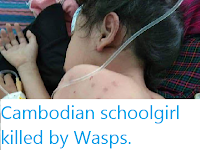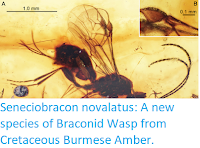Braconid Wasps are small parasitoid wasps (Wasps whose larvae grow
inside the bodies of a living animal host) targeting a variety of Insect
and Spider species. They are unusual in that they will lay multiple
eggs within the same host (most parasitoid Wasps lay a single egg on
each host), thereby allowing multiple larvae to mature within a large
host, which is not necessarily killed in the process. Braconid Wasps are
often fearsome in appearance, but are other than to targeted host
species as they lack stings. The braconid genus Vipio is most diverse in the Holarctic Region but has a significant representation in the Neotropical Region. However, little is known of these tropical species, only a very few of which are described, nor are there any host records for the species from this part of the world.
In a paper published in the journal ZooKeys on 8 April 2020, Donald Quicke of the Integrative Ecology Laboratory at Chulalongkorn University, Scott Shaw of the Department of Ecosystem Science and Management at the University of Wyoming, Mian Inayatullah of the Department of Entomology at the NWFP Agricultural University, and Buntika Butcher, also of the Integrative Ecology Laboratory at Chulalongkorn University, describe five new species of Vipio from Central and South America as part of a review of the genus in the Neotropical Region.
The first new species described is named Vipio boliviensis, meaning 'from Bolivia'. The species is described on the basis of three female specimens, one collected near the town of Comarapa in Santa Cruz Department, Bolivia, and two from Entre Ríos Province in north-eastern Argentina. This species reaches a length (excluding the ovipositor) of 5.4 mm with an ovipositor length of 6.4 mm, and a forewing length of 5.6 mm. It is yellowish red in colour, except for the head, antennae, palpi (segmented appendages near the mouth of an arthropod), prosternum (ventral plate of the prothorax of an insect) legs, and ovipositor, which are black, and the abdomen, which is yellow and black.
Vipio boliviensis, female in lateral view. Quicke et al. (2020).
The second new species is named Vipio carinatus, for the presence of distinctive carinae (ridges) on the propodeum (first abdominal segment) of this species. The species is described from two female specimens from Santa Cruz Department, Bolivia, and a male from Chaco Province in Argentina. The females of this species reach 4.6-5.0 mm in length, excluding the ovipositor, with an ovipositor 2.5 mm in length and a forewing length of 4.6-5.0 mm. The male is 6.2-6.5 mm in length (the specimen was collected in 1948 and is dehydrated, preventing an accurate estimate). This species is predominantly yellowish-orange in colour, except for the head and antennae, which are black, and the sides of the face and mandibles, which are blackish red. The legs are blackish red and yellow, the wings brown with dark brown venation.
Vipio carinatus, female in lateral view. Quicke et al. (2020).
The third new species described is named Vipio godoyi, in honour of Carolina Godoy, of the Instituto Nacional de Biodiversidad, who assisted with collection of the holotype specimen. The species is described from two female and ten male specimens collected from Costa Rica, Honduras, Nicaragua, and Panama. Females of this species reach 7.1 mm in length with an ovipositor length of 3.8 mm and a forewing length of 7.1 mm. Males reach 7.5-7.9 mm in length. This species is reddish yellow in colour, apart from the except head, including mouthparts and antenna, legs, ovipositor sheath, and wings, which are black.
Vipio godoyi, female in lateral view. Quicke et al. (2020).
The fourth new species described is named Vipio hansoni, in honour of Paul Hanson, of the Universidad de Costa Rica, who collected the holotype specimen. The species is described from three female and two male specimens, all collected in Costa Rica. The females of this species reach 5.5 mm in length, with an ovipositor length of 2.9 mm and a forewing length of 5.5 mm. The males reach 3.3-3.5 mm in length. This species is reddish yellow except head, legs, propleuron, and ovipositor sheath, which are black, and the wings, which are brown.
Vipio hansoni, female in lateral view. Quicke et al. (2020).
The final new species is named Vipio lavignei, in honour of Robert Lavigne, for his diverse contributions to entomological research and his role in promoting the insect systematics program at the University of Wyoming. The species is described from four specimens, two females from Leoncio Prado Province in Peru and two males from Tucumán Province in Argentina. Females of this species reach 9.0-9.2 mm in length, with an ovipositor length of 3.3 mm, and a forewing length of 8.2-8.8 mm. Males reach 7.9 mm in length. This species is predominantly black, apart from some yellow markings around the eyes and the thorax, which is red with a black tinge.
Vipio lavignei, female in lateral view. Quicke et al. (2020).
See also...
Follow Sciency Thoughts on Facebook.











